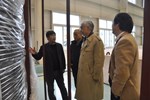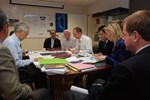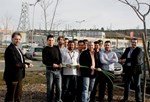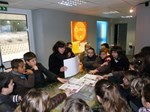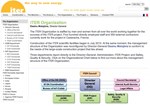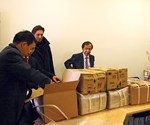I would like to take this opportunity to report on the latest project developments. Directly after the last meeting of the
ITER Council in November during which the delegates confirmed the choices made in policy and strategy to advance the design and construction of ITER, I set off on a mission to Japan and China.
On 24 November I was asked to give a testimony on the status of the ITER project to the Special Committee on Science, Technology and Innovation of the Japanese House of Representatives, chaired by Mr. Isao Matsumiya. The meeting lasted for almost three hours and the Representatives, of course, had many questions. They wanted to know how "solid" the ITER Project was, what is its present status, how safe the machine will be, etc. All in all, it was a very encouraging meeting. It will help the Japanese Representatives to understand and to further endorse the importance of fusion and to explain this necessity to their constituents.
I had another very constructive meeting the next day—this time with the Parliamentary Association and its President Yorihisa Matsuno and Secretary General Hirofumi Ryu. This Association was only established recently to support ITER. The idea to establish such a group was floated during lunch at the Château de Cadarache when a delegation of Japanese Members of Parliament visited ITER on 11 October this year. They said they would hold their first meeting during my next visit to Japan, and they did. The Association, which will act as a "bridge between the Japanese government and the ITER Project," is growing fast. More than 100 Parliament Representatives got together to celebrate the inauguration, among them the former ministers of MEXT, Mr. Takeo Kawamura and Mr. Kenji Kosaka, who are extremely supportive of our project.
From Tokyo, my wife and I flew to Beijing to the Ministry of Science and Technology (MOST), where I met Vice-Minister Cao Jianlin to discuss the ITER Project schedule, its cost, and human resource issues in depth. I expressed my sincere appreciation for China's continuous support to ITER and for their understanding of the series of reforms we have undertaken to ensure successful project implementation during the construction phase. Mr. Cao replied by reassuring me that China would keep to its commitments and complete its fabrication tasks on time. Besides in-cash and in-kind contribution, China is planning to strengthen its human resource support to the ITER Organization in the coming few years, including sending more visiting researchers and providing more expertise.
The next stop before I moved on to Hefei was the Chinese Domestic Agency where I gave a comprehensive presentation on the project's status, the impact of the Fukushima earthquake and tsunami on the overall project schedule, and the strategic management plan of ITER. I was happy to get this opportunity to exchange views with the staff and experts at the Chinese Domestic Agency.
Hefei is the hometown of the Institute of Plasma Physics at the Chinese Academy of Sciences (ASIPP) and the home of the EAST Tokamak. This was my first trip to ASIPP since attending the second EAST International Advisory Committee meeting in October 2006 and I must say that it was with both great pleasure and great excitement that I returned.
I was cordially received by ASIPP Director Li Jiangang together with Academician Wan Yuanxi, the former chairman of the ITER Science and Technology Advisory Committee (STAC), Deputy-Directors Wan Baonian, Fu Peng and Wu Xinchao, and representatives from the ITER Domestic Agency (ITER China) and ASIPP ITER office officials. Professor Li presented an overview of recent research progress at EAST and ITER activities at ASIPP. In his talk, he emphasized that the development of 40 diagnostic tools, the achievement of long-pulse H-mode, and other research performed on EAST will provide "a wealth of experience" for ITER. "We want ITER to succeed, as we are all in the same boat," Jiangang Li said, as he assured me of ASIPP's strong commitment to ITER.
The following day I attended a very moving ceremony hosted by ASIPP that celebrated the delivery of the first 780-metre copper dummy conductor for ITER's toroidal field coils. This is the first ITER component "made in China." Of this, 640 metres will be shipped to Japan and the other 140 metres to Europe for testing.
Needless to say, the ceremony in China celebrated a major milestone toward the success of the ITER Project. In front of some fifty participants, I was invited—together with Vice Minister Cao Jianlin of MOST—to ignite an electric-optic ball (see picture) to symbolize the transport of the first component and the "ignition of the shared dream of fusion energy."
Together with Minister Cao I also attended the ITER Training Forum hosted by the University of Science & Technology of China (USTC). Vice Minister Cao gave a speech on the "Fusion Energy Development strategy in China and ITER," which left no doubt about the country's intention to take fusion energy to the power grids. I, in return, gave a keynote speech on the progress of the ITER Project and the improvements made.
In order to promote academic and scientific cooperation between the ITER Organization and the USTC, President Hou Jianguo and I signed a
Memorandum of Understanding. The key to our cooperation will be the training of young fusion scientists—a worthy pursuit which I also emphasized in the speech I gave on the occasion of receiving a USTC Honorary Professorship. I feel very honored receiving this commendation and I wish to thank President Hou and all the USTC staff once more for the nice arrangement and their hospitality.
It is my goal to open the door of ITER to young people who will in fact have the responsibility in the future to carry fusion research forward and to develop the ITER Organization to become a true Center of Excellence.
With these words I would like to close my column and take the opportunity to thank all of you for the excellent work accomplished this year. And what a year it was: The tragedy that happened in Fukushima and consequences on the project's manufacturing schedule as well as the tight budget together with the worries about the European funding have exposed our nerves to a rather unique stress test. Nevertheless, we have managed to overcome the challenges—and more.
ITER is coming out of the ground and, having witnessed what is happening in industry, I can say we are definitely moving from design to real components. But our job is not done yet. Building ITER is a long-distance run and so I hope you will enjoy the Christmas break with friends and family to relax and recharge your batteries and to get ready for the excitement to come!
Thank you and see you in the New Year.


